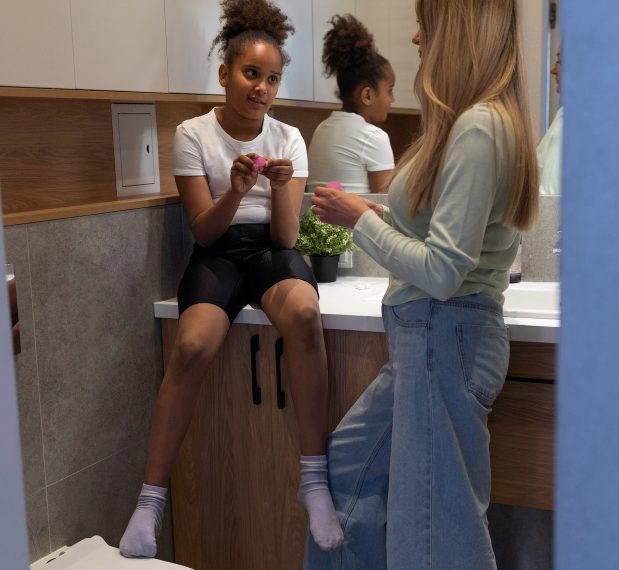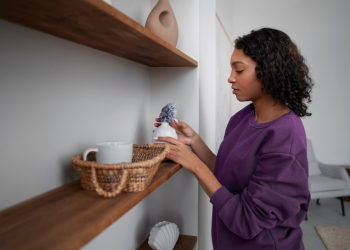Small bathrooms often feel like a design limitation—but in reality, they offer a powerful opportunity for creative transformation. With the right materials, especially tile, you can maximize both style and function while creating the illusion of a larger space. Tile isn’t just a protective surface—it’s a design element that can expand, brighten, and elevate your bathroom when used thoughtfully.
In this article, we’ll explore expert-backed strategies to make your small bathroom appear more spacious, all through the strategic use of tile. Whether you’re renovating your home, working with a designer, or browsing options at a local tile store, these ideas will help you plan smart, look stylish, and make the most of every square inch.
1. Use Larger Tiles to Create Continuity
Contrary to popular belief, large tiles aren’t just for expansive bathrooms. In fact, larger format tiles are a powerful design tool in compact spaces. Why? Because they reduce the number of grout lines, making surfaces appear less cluttered and more continuous.
Why it works:
- Fewer grout joints = less visual interruption
- Surfaces appear smoother and more expansive
- It mimics the effect of a larger room
Tile sizes to consider:
- 12″x24″ (ideal for small to medium bathrooms)
- 24″x48″ (best for floors or full shower walls)
- Large plank-style tiles (great for wood-look designs)
Avoid mosaic-heavy or checkerboard patterns on the floor unless they’re used deliberately for an accent or feature.
2. Stick to a Light, Monochromatic Color Palette
Color has a major impact on spatial perception. In small bathrooms, it’s best to keep things light and cohesive. Light-colored tiles, especially in shades of white, beige, light grey, or pastel tones, reflect more light and visually open up the room.
Consider these finishes:
- Glossy ceramic or porcelain for wall tiles
- Polished stone-look porcelain for the floor
- Glass mosaics for accent areas that reflect light
To create a serene and seamless look, match tile colors to paint, cabinetry, and even fixtures. This “tone-on-tone” approach minimizes visual contrast and makes the space feel unified and airy.
3. Choose the Right Tile Layout
The layout of your tile can dramatically affect how the room feels. Even without changing the physical size of the bathroom, your layout can manipulate the way we perceive dimensions.
Layout tips:
- Vertical stacking makes walls appear taller
- Horizontal layouts visually widen the room
- Diagonal tile patterns on the floor create a sense of depth
- Herringbone and chevron patterns add movement and elongation
Avoid busy or overly small patterns unless you’re using them strategically in an accent niche or strip.
4. Go Wall-to-Wall and Floor-to-Ceiling
Continuity is everything in a small space. One of the most effective techniques is tiling entire walls and the full floor area using the same or similar materials. This eliminates transitions that “chop up” the space and instead creates a unified, spa-like vibe.
If tiling all four walls isn’t practical, consider:
- Tiling one full feature wall, such as the back of the shower
- Running floor tile into the shower area uninterrupted
- Tiling half the wall height and painting above in a matching shade
For a sleek, high-end look, go for rectified tiles with minimal grout spacing.
5. Match Grout to Tile Color
Grout lines have more visual impact than most people realize. In tight spaces, high-contrast grout can create a grid-like effect that emphasizes the small scale of the tile—and the room.
To avoid this, choose grout that closely matches the tile color. This makes the lines “disappear,” resulting in a more seamless and expansive appearance.
If you’re using textured or patterned tiles, opt for a slightly lighter or darker grout tone to retain subtle definition without harsh contrast.
6. Use Reflective Surfaces and Materials
In small spaces, light is your best friend. One of the most effective ways to amplify light—natural or artificial—is by using tiles with reflective finishes.
Great options include:
- Glossy ceramic tiles for the wall
- Glass or iridescent mosaics as accents
- Light marble-look porcelain with a polished finish
Pro tip: Place reflective tiles near light sources, mirrors, or windows to bounce light and create the illusion of openness.
7. Blur the Line Between Shower and Bathroom
One of the best tricks for visually enlarging a bathroom is removing the separation between the shower and the rest of the space.
Here’s how:
- Use the same tile on the floor and shower area
- Avoid shower curbs or thresholds—opt for a curbless entry
- Continue wall tile from the shower into the main space
- Install a clear glass shower enclosure (or no door at all)
This technique makes the floor appear larger and gives the space a clean, uninterrupted flow.
8. Strategic Accent Tiles for Visual Depth
While minimalist designs help open up small spaces, strategic use of accent tiles can add character and visual interest. The key is subtlety and smart placement.
Where to use them:
- Vertical strips in the shower to draw the eye upward
- Niches and alcoves with contrasting textures or mosaics
- Behind the vanity as a backsplash
- On the floor in a gentle geometric pattern
Stick to tone-on-tone or monochromatic accents rather than bold or high-contrast color choices to maintain an expansive feeling.
9. Combine Tile with Minimal Fixtures
To enhance the effect of your tile choices, pair them with wall-mounted vanities, floating toilets, and open shelving. These design elements reduce visual bulk and reveal more of the tiled floor and walls, further amplifying the sense of space.
If you’re tiling a powder room, consider a pedestal sink or console sink with exposed plumbing to keep the room open and airy.
10. Maximize Natural Light and Mirror Placement
While not directly tile-related, light and mirror placement work hand-in-hand with tile finishes to enhance spatial perception.
Tips:
- Install a large mirror above the vanity or across one full wall
- Choose mirror cabinets that reflect floor and wall tile
- Place light fixtures where they bounce off glossy or reflective tile surfaces
When tile, mirrors, and lighting work in harmony, even the smallest bathroom feels luxurious and full of life.
Final Thoughts
Designing a small bathroom may feel like a puzzle, but the right tile can completely transform the space. By focusing on scale, color, layout, and reflectivity, you can create a bathroom that feels larger, brighter, and beautifully cohesive—without knocking down walls or expanding square footage.
When selecting your materials, remember to visit a trusted tile store where you can see full-size samples and receive expert design guidance. It’s all about combining function with aesthetic flow.
With a bit of planning and smart design choices, your small bathroom can have big style and make a lasting impression.










